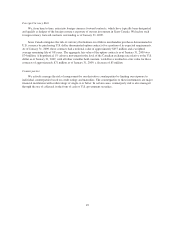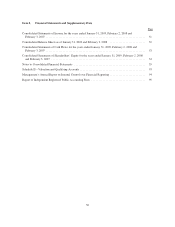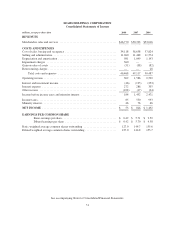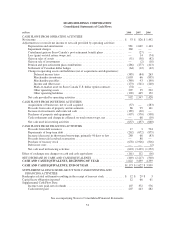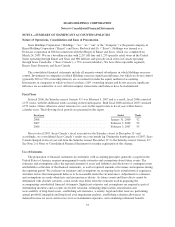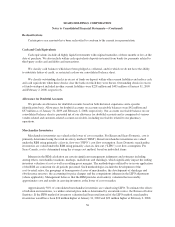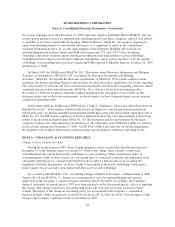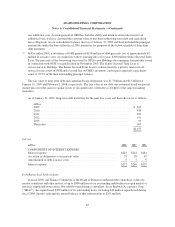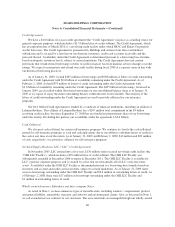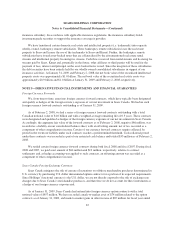Sears 2008 Annual Report Download - page 58
Download and view the complete annual report
Please find page 58 of the 2008 Sears annual report below. You can navigate through the pages in the report by either clicking on the pages listed below, or by using the keyword search tool below to find specific information within the annual report.SEARS HOLDINGS CORPORATION
Notes to Consolidated Financial Statements—(Continued)
Goodwill, Trade Names, Other Intangible Assets and Related Impairments
Trade names acquired as part of the Merger account for the majority of our intangible assets recognized in
the consolidated balance sheet. The majority of these trade name assets, such as Kenmore, Craftsman and Lands’
End, are expected to generate cash flows indefinitely, do not have estimable or finite useful lives and, therefore,
are accounted for as indefinite-lived assets not subject to amortization. Certain intangible assets, including
favorable lease rights, contractual arrangements and customer lists, have estimable, finite useful lives, which are
used as the basis for their amortization. The estimated useful lives of such assets are determined using a number
of factors, including the demand for the asset, competition and the level of expenditure required to maintain the
cash flows associated with the asset.
As required by SFAS No. 142, we perform annual goodwill and intangible assets impairment tests in the
fourth quarter and update the tests between annual tests if events or circumstances occur that would more likely
than not reduce the fair value of a reporting unit below its carrying amount. A significant amount of judgment is
involved in determining if an indicator of impairment has occurred. Such indicators may include, among others: a
significant decline in our expected future cash flows; a sustained, significant decline in our stock price and
market capitalization; a significant adverse change in legal factors or in the business climate; unanticipated
competition; and the testing for recoverability of a significant asset group within a reporting unit. Any adverse
change in these factors could have a significant impact on the recoverability of these assets and could have a
material impact on our consolidated financial statements.
Our goodwill resides in multiple reporting units. The goodwill impairment test involves a two-step process.
The first step is a comparison of each reporting unit’s fair value to its carrying value. We estimate fair value
using the best information available, including market information and discounted cash flow projections, also
referred to as the income approach. The income approach uses a reporting unit’s projection of estimated
operating results and cash flows that is discounted using a weighted-average cost of capital that reflects current
market conditions. The projection uses management’s best estimates of economic and market conditions over the
projected period including growth rates in sales, costs, estimates of future expected changes in operating margins
and cash expenditures. Other significant estimates and assumptions include terminal value growth rates, future
estimates of capital expenditures and changes in future working capital requirements.
If the carrying value of the reporting unit is higher than its fair value, there is an indication that impairment
may exist and the second step must be performed to measure the amount of impairment loss. The amount of
impairment is determined by comparing the implied fair value of reporting unit goodwill to the carrying value of
the goodwill in the same manner as if the reporting unit was being acquired in a business combination. See Notes
13 and 14 to the Consolidated Financial Statements for further information regarding goodwill and related
impairment charges recorded during fiscal 2008.
Financial Instruments and Hedging Activities
From time to time, we use derivative financial instruments, including interest rate swaps and caps, to
manage our exposure to movements in interest rates, and foreign currency forward contracts to hedge the foreign
currency exposure of our net investment in Sears Canada against adverse changes in exchange rates. In addition,
we entered into total return swaps during fiscal 2007 and 2006 as a means for investing a portion of our surplus
cash. We recognize all derivative instruments at fair value within either other assets or other liabilities on our
consolidated balance sheet.
When applying hedge accounting treatment to our derivative transactions, we formally document our hedge
relationships, including identification of the hedging instruments and the hedged items, as well as our risk
management objectives and strategies for undertaking the hedge transaction. We also formally assess, both at
58



